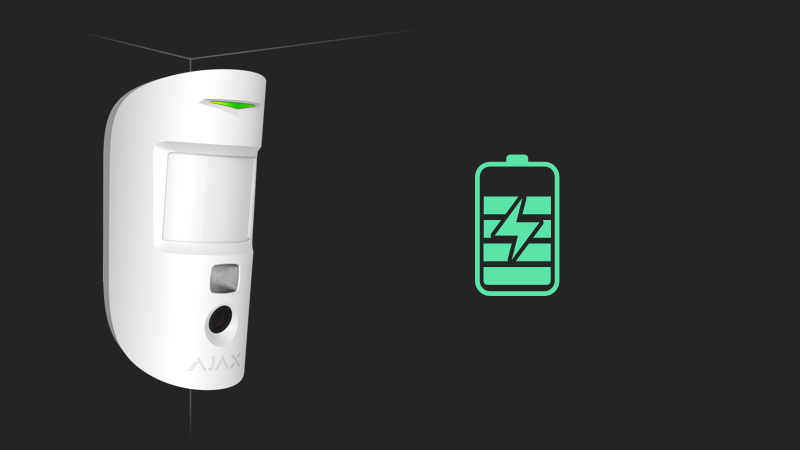The MotionCam motion detector with alarm photo verification runs up to 4 years from bundled batteries with Photo on demand toggle disabled and up to 3 years with Photo on demand toggle enabled. However, this term can be reduced to 2.5 years if an entry delay is used, or a short ping interval of detectors or high resolution of images is specified. This article specifies how we calculated the battery life and how it is affected by the detector settings and conditions of use.
Type of batteries used in the detector
MotionCam runs on two CR123A batteries.
The detector is equipped with Panasonic Photo Battery Lithium CR123AL/1 BP 3V/1400mAh. Such batteries are highly tolerant to temperature drops and maintain a sufficient level of charge even at -10°C, which is the boundary temperature for the detector operation.
MotionCam detector operating temperature range depends on the device manufacture date.
To find out the manufacture date of your device, please follow the link.
How we calculated the battery life
When calculating the battery life, we assumed that the detector takes 100 photos (50 with sufficient lighting and 50 in poor lighting with IR backlight) throughout the entire battery life. In the dark, the detector makes photos with an infrared backlight, which can increase the energy consumption by one series of photos up to 3 times.
We also assumed the good signal strength between the hub and the detector (3 bars). The worse the quality of communication between MotionCam and the hub is, the longer the detector uses the radio module, and consequently, the higher is the energy consumption for transmitting photos.
We calculated the operating time with standard detector settings: the normal sensitivity of the PIR sensor, the disabled Delay When Entering setting, and the camera making a series of three photos with a resolution of 320 × 240 pixels per alarm. The detector ping interval is 36 seconds.
| At +23°C | At +10°C | At 0°C | At -10°C | |
| MotionCam bundled battery life | 4,2 years | 4,1 years | 4 years | 3,3 years |
How detector settings affect the battery life
The detector with a high sensitivity of the PIR sensor can be triggered by large and active pets or by other thermal interferences. Each of such triggering means additional energy consumption. The higher the resolution of the photo, the more time (and therefore energy) the detector spends on its transmission. For instance, energy consumption when transmitting a photo with a resolution of 640 × 480 pixels can be 4 times higher than when transmitting a photo of 320 × 240 pixels.
When shortening detectors ping interval, keep in mind that this affects the battery life as the detector will use a radio module more often, responding to the hub.
| Polling period of 36 seconds (default) |
Polling period of 24 seconds | Polling period of 12 seconds | |
| MotionCam bundled battery life | 4,2 years | 3,7 years | 2,7 years |
When the Delay When Entering setting is active, the detector is triggered when a person appears in the detection zone, takes a photo, but waits until the end of the delay time to transfer it to the hub. If the system is disarmed before the end of the entry delay, no alarm is raised. Otherwise, the photos are transferred to users and the security company. This approach ensures that even when an entry delay is used, visual confirmation allows you to restore the penetration path from the moment the intruder appears in the protected area.
The Delay When Entering setting can shorten the life of MotionCam batteries by up to 2.5 years (in the temperature range from 0°C to +23°C).
When to replace batteries
The system will remind you in advance of the need to replace the detector batteries. With standard settings, the batteries will run for another 6 months after low charge notification, and will deplete 2 to 4 months later if the Delay When Entering setting is used.
We recommend installing Panasonic CR123A Industrial Lithium Battery, 3 V (item model number — 4330203048, manufacturer — Indonesia) to ensure that the Ajax device operates for the calculated time. If other batteries are installed, the operating time may differ from the calculated time.
To extend MotionCam battery life:
- Use the maximum photo resolution only when the information content is insufficient
- Do not shorten the ping interval of detectors by the hub unless it is necessary
- Locate the detector in a place with a good Jeweler and Wings signal strength
- Do not install the detector in the premises whose temperature is outside the permissible limits: -10°C (for devices with manufacture date from June 1, 2020) to +40°C
